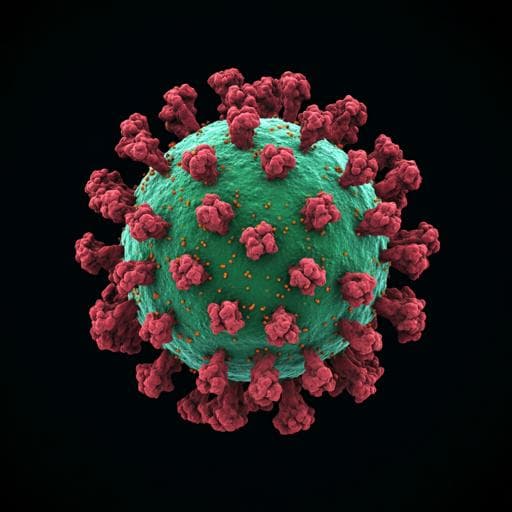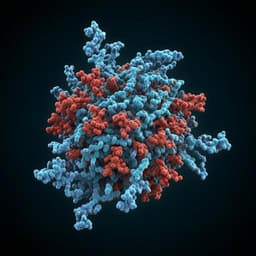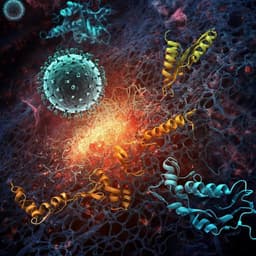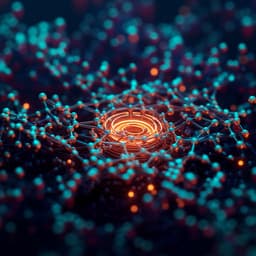
Medicine and Health
Structural insights into the modulation of coronavirus spike tilting and infectivity by hinge glycans
D. Chmielewski, E. A. Wilson, et al.
This groundbreaking study by David Chmielewski, Eric A. Wilson, and colleagues unveils the intricate structure and dynamics of coronavirus spikes, shedding light on their infectivity. Utilizing advanced techniques like cryo-electron tomography and mass spectrometry, the research pinpoints critical glycosylation roles, offering novel insights into potential therapeutic targets for HCoV-NL63.
~3 min • Beginner • English
Introduction
The study addresses how conformational dynamics of full-length coronavirus spikes embedded in the viral membrane relate to infectivity, focusing on the role of glycosylation in modulating spike bending. While many high-resolution structures of soluble spike crowns exist, the flexible stalk and its glycans remain poorly resolved in situ, and chemical fixation used in prior studies may alter dynamics. HCoV-NL63, an alphacoronavirus that binds human ACE2, presents a densely glycosylated spike with a closed crown conformation. The authors aim to define the native conformational landscape of intact spikes on virions, map site-specific glycosylation, and determine how hinge-region glycans regulate spike tilting and influence viral entry, thereby informing immune evasion and therapeutic targeting.
Literature Review
Prior structural work delineated prefusion spike crowns for multiple coronaviruses, with betacoronaviruses exhibiting RBD up/down transitions, whereas many alphacoronaviruses show a closed RBD conformation. In situ studies on SARS-CoV-2 suggested stalk-mediated bending and hinge flexibility, though those virions were chemically fixed. Glycan shields are known to mask epitopes and modulate conformational transitions (e.g., SARS-CoV-2 S1 glycans affecting RBD). However, stalk structure/glycans remain unresolved, and links between native full-length spike dynamics, glycan composition, and infectivity have not been established. This work builds on cryoEM/ET, glycomics, and MD studies of CoV spikes and other viral glycoproteins (e.g., HIV-1 Env, influenza HA) to interrogate NL63 spike dynamics and glycan-mediated regulation.
Methodology
- Virus production and purification: HCoV-NL63 produced in cell culture, purified by ultracentrifugation and OptiPrep gradients; unfixed virions used for imaging.
- CryoET data acquisition and processing: 176 tomograms collected on a 200 kV Talos microscope with K2 detector, tilt range −50° to +50°. 18,365 spike trimer subvolumes extracted. Subtomogram averaging with C3 symmetry achieved 6.9 Å for the crown and ~11–11.5 Å for upper stalk and membrane; focused classification assessed RBD/domain A states; bending and azimuthal angles computed and class-averaged.
- Glycoproteomics (LC–MS/MS): Multiple protease digestions of virion-derived S, analysis by Orbitrap Eclipse. Site-specific glycan occupancy and glycan-type distributions (high-mannose, hybrid, complex) determined at all 39 N-glycosylation sequons per protomer; manual validation of assignments; deglycosylation used to assess occupancy.
- Model building and glycan modeling: Crown model from prior single-particle cryoEM refined; stalk monomer predicted by I-TASSER and cross-validated by AlphaFold; trimer assembled, flexible fitting (MDFF) into cryoET densities. Glycans added using CHARMM-GUI/GLYCAM/Modeller to build fully glycosylated spikes consistent with MS data.
- Molecular dynamics simulations: Seven full-length glycosylated spike ectodomain models at different tilt angles subjected to explicit solvent (NAMD, CHARMM36) followed by implicit solvent simulations to enhance sampling; total sampling ~3.15 μs across conditions. Additional implicit simulations (cumulative ~21.5 μs) probed glycan deletions: ΔN1242, ΔN1247, double deletion, all glycans removed, and all except hinge glycans.
- Accessibility analyses: Solvent-accessible surface area for Fab-sized probe (20 Å radius) computed to quantify epitope masking across coronavirus spikes; hinge glycan–protein contacts and interaction energies quantified versus bending angle.
- Infectivity assays: VSV-Luc pseudoviruses bearing WT or mutant HCoV-NL63 S (Asn to Asp at N1242 and/or N1247) used to infect HEK293-ACE2-TMPRSS2 cells at MOIs 0.1, 1.0, 10; intracellular luciferase measured post infection and normalized to WT. Statistical analyses included two-way ANOVA with multiple-comparison corrections and t-tests for simulation distributions.
Key Findings
- Native conformations on virions: Spike crowns exhibit extensive tilting relative to the stalk, up to 80°, with a median of ~41.6°. Azimuthal tilt directions are broadly distributed, indicating isotropic rotational freedom around the hinge localized ~100 Å above the membrane. RBDs are in a closed, down conformation; no up states detected.
- Resolution and mapping: Subtomogram averaging resolved the crown at 6.9 Å and upper stalk/membrane at ~11–11.5 Å; secondary structures in the crown match prior models.
- Glycan profile: All 39 N-glycosylation sequons per protomer characterized; 36 on the crown, 3 on the stalk. Of the 36 crown sites, 29 (>80%) predominantly carry high-mannose (Man4–6GlcNAc2) glycans. Glycans that engage nearby protein surfaces show higher resolvability (higher Q-scores), implicating glycan–protein stabilization.
- Glycan shield and immune evasion: HCoV-NL63 spike surface is densely glycosylated with oligomannose-dominant glycans, masking receptor-binding motifs (e.g., N486, N506, N512 on RBD; N358 at A–B interface) and S2 activation loop via interprotomer glycan clusters. Fab-accessible residues reduce from 1431 (no glycans) to 1056 (with glycans) for NL63; across CoVs, NL63 exhibits fewer Fab-accessible residues than others, suggesting higher immune evasiveness.
- Hinge definition and dynamics: A disordered loop (residues ~1226–1245) separates two coiled-coil stalk segments and localizes bending. Hinge-region glycans at N1242 and N1247 sit between upper and lower coiled-coils, modulating bending and shielding a stem-helix epitope.
- MD-experiment agreement: Simulated bending angle distributions match cryoET-derived landscapes, with favored conformations and hierarchical bending centered near ~56°, which also corresponds to minimal stem-helix epitope accessibility and favorable glycan–protein interactions (strongest at 30°–60°).
- Glycan deletion effects on bending: Removing both hinge glycans shifts distribution toward straighter spikes (peak ~25°). ΔN1242 alone peaks at ~20°–25° (straighter) versus ΔN1247 peaking at ~40°–45°. Removing all glycans peaks ~20°. Statistical deviation from WT is significant (p < 2×10^−6), indicating N1242 glycan exerts stronger control over bending than N1247.
- Infectivity impact: Pseudovirus assays show that deleting N1242 glycan (alone or with N1247) reduces HCoV-NL63-mediated infection by ~70% across MOIs (0.1, 1, 10), whereas deleting N1247 alone has minimal effect, implicating N1242 glycan in efficient virus entry.
- Conservation: N-glycosylation sequons for hinge glycans (N1242, N1247) are highly conserved across alpha-, beta-, gamma-, and delta-coronaviruses, underscoring functional importance.
Discussion
The study demonstrates that the HCoV-NL63 spike’s orientational freedom is governed by a hinge in the upper stalk, whose dynamics are modulated by specific N-glycans, particularly at N1242. Integrating in situ cryoET with all-atom simulations links glycan-mediated stabilization at intermediate bends (30°–60°) to reduced epitope accessibility of the stem-helix region, offering a mechanism for immune evasion. The dense, oligomannose-dominant glycan shield contributes to extensive masking of neutralizing epitopes, including RBD-adjacent regions and S2 activation loops, and likely explains the compact, stable crown conformation and limited adaptive evolution in NL63 relative to other seasonal CoVs. Functional assays corroborate the structural and computational findings: loss of the N1242 glycan reduces infectivity, suggesting that optimal bending facilitated by this glycan promotes productive receptor engagement/fusion. Conservation of the hinge glycan sequons across coronaviruses indicates a broader relevance of hinge glycan-mediated modulation of spike function and immune evasion, highlighting the stalk–hinge region as a potential therapeutic and vaccine target, akin to stem-helix epitopes targeted by broadly neutralizing antibodies in betacoronaviruses.
Conclusion
This work provides an in situ structural and mechanistic framework linking site-specific glycosylation to spike tilting dynamics and infectivity for HCoV-NL63. Key contributions include: (1) definition of a broad bending landscape mediated by an upper-stalk hinge; (2) comprehensive mapping of spike glycosylation showing an oligomannose-rich shield with extensive epitope masking; (3) identification of hinge glycans, especially N1242, as modulators of bending that optimize both shielding and infectivity; and (4) functional validation that N1242 glycan promotes viral entry. These findings suggest the hinge/stem-helix region as a therapeutic target—either by disrupting glycan–protein interactions that favor optimal bending or by focusing immune responses on conserved, transiently exposed stalk epitopes. Future studies should incorporate the transmembrane domain and membrane environment, expand tomographic sampling and sub-tomogram averaging to refine stalk architectures, and explore pan-coronavirus vaccine designs that exploit conserved stalk vulnerabilities.
Limitations
- The transmembrane domain and membrane anchor were not modeled, and explicit protein–membrane interactions were not included, potentially affecting stalk dynamics and hinge behavior.
- The lower stalk coiled-coil region retained uncertainties despite combined I-TASSER/AlphaFold/MDFF modeling, with limited resolution in cryoET maps.
- MD simulations, while guided by experimental maps, have finite sampling; azimuthal angle space was undersampled relative to cryoET distributions, and longer trajectories may reveal additional rare conformations.
- Some methodological inconsistencies (e.g., post-infection timepoints in infectivity readouts) and reliance on pseudovirus systems may limit direct extrapolation to authentic virus entry.
- Chemical environments on the virion (e.g., lipid composition, host factors) and potential effects of sample preparation may influence dynamics but were not explicitly modeled.
Related Publications
Explore these studies to deepen your understanding of the subject.







